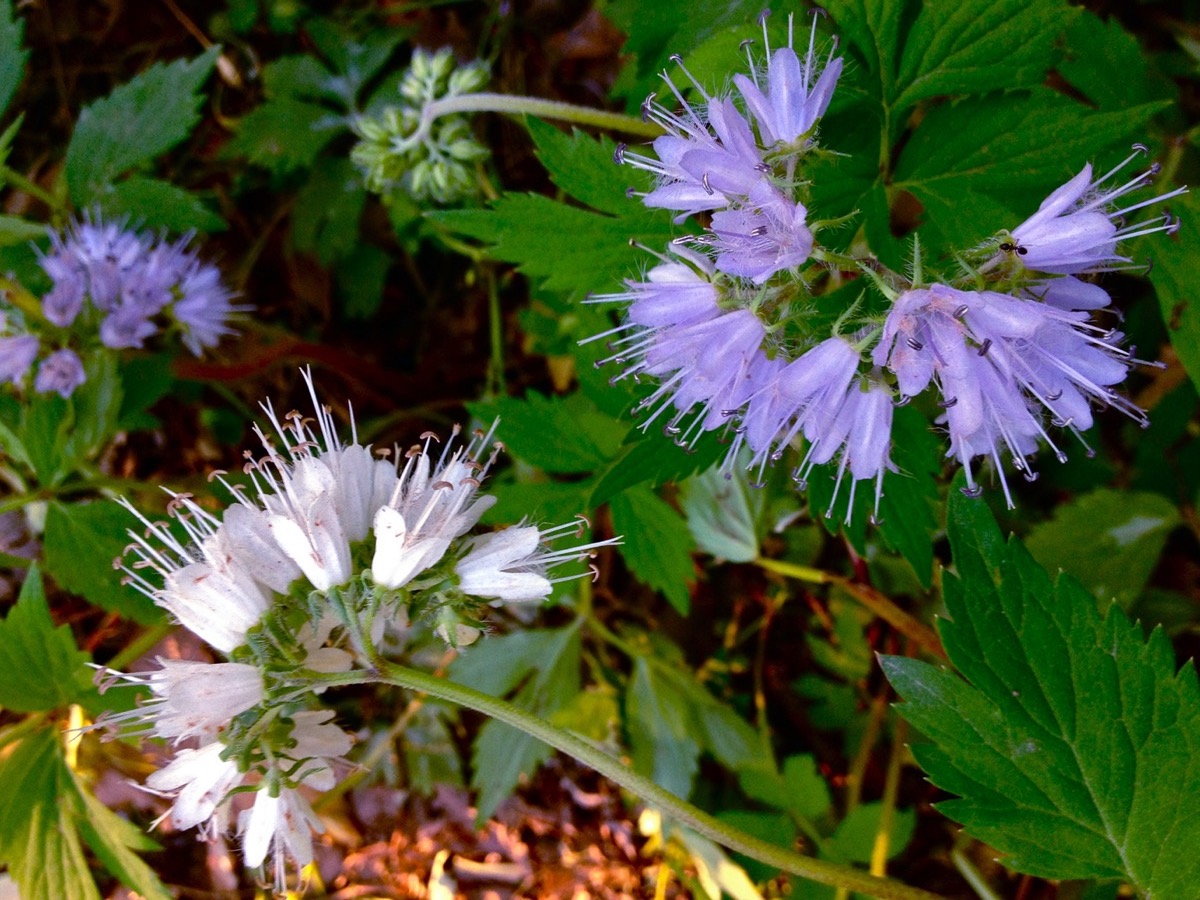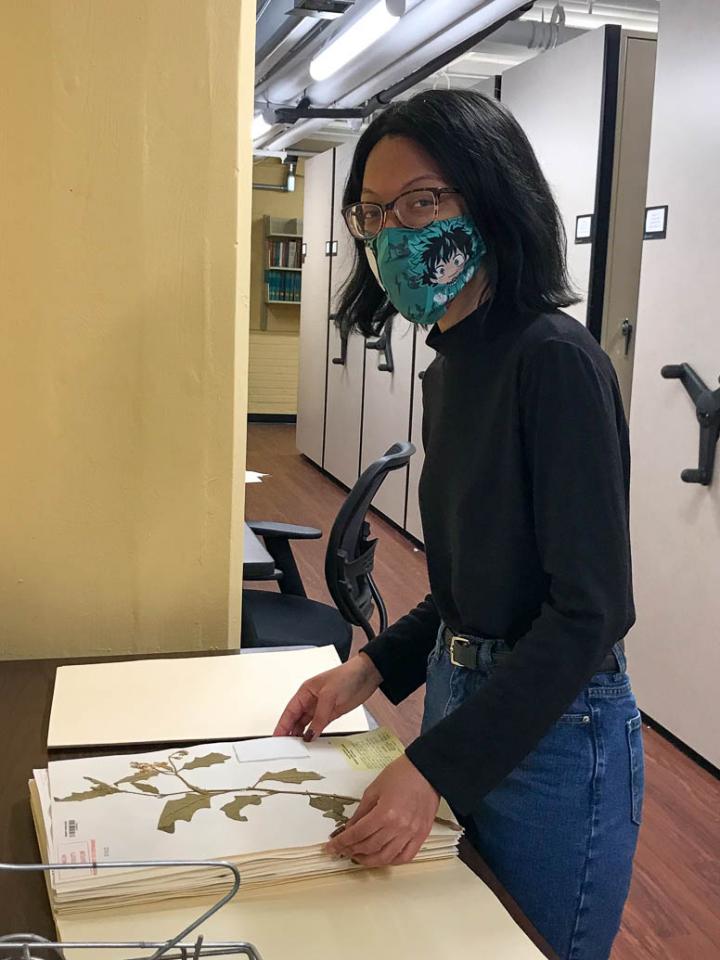Flowers Are Finding New Hues In A Climate Crisis
8:16 minutes

It’s that time of the year where flowers bloom and the world starts to feel more colorful after a dormant winter. But what if the colors of the flowers we see now aren’t the same as they were a century ago?
New research from Clemson University scientists finds that climate change has impacted the hues of flowers. Temperature and aridity changes since 1895 have caused some flowers to go from purple to white, and others from white to purple.
Ira is joined by the lead researcher and Clemson Department of Biological Sciences graduate student Cierra Sullivan to talk about these strange changes, and the possible impact on the pollinators we know and love.

Invest in quality science journalism by making a donation to Science Friday.
Cierra Sullivan is a graduate student in the Clemson University Department of Biological Sciences in Clemson, South Carolina.
IRA FLATOW: While we’re on the topic of climate change and plants, there is something else that’s been happening to our plants because of a warming planet. I’m talking about flower colors are changing. Yeah. A new study looked at flower records as far back as the 1800s and found that the flowers of some species in the US have sort of morphed into lighter shades of color. Some are more vibrant. What’s going on here?
Well, the lead author of that study joins us to explain, Cierra Sullivan, a graduate student at Clemson University’s Department of Biological Sciences in Clemson, South Carolina. Welcome to Science Friday.
CIERRA SULLIVAN: Hi. Thank you so much for having me. It’s great to be here.
IRA FLATOW: So nice to have you. Let’s talk about this. So flower colors are changing? Is there a pattern? They’re changing from one color to another?
CIERRA SULLIVAN: Yeah. So actually some flowers are becoming darker, becoming more of your purples and pinks. Whereas some are actually becoming whiter and being more white and cream in color.
IRA FLATOW: Can you give me an idea? If I go outside this spring and I go to look at a flower in my flower bed, is there any flower I could look at to say, hey, that used to be purple, or it’s getting more purple or something like that?
CIERRA SULLIVAN: There could be some. There are some species, I guess. They’re wild but some like to put in their lawn. So if you’re familiar with something called Dame’s or Rocket or there’s something called Nodding Onion that would looked at. It’s also wild. It’s an onion. So depending on how much of a plant person, you may already have these in your garden. Or if you go on trails, you might be able to see them all over the United States.
IRA FLATOW: Wow. And so over what period of time are we talking about for this change to happen?
CIERRA SULLIVAN: So this was– our oldest plant was from 1895. And our most recent one was from 2019. So that’s over a span of 124 years.
IRA FLATOW: Wait. You said 2019. Are you saying that something changed from 2019 till now?
CIERRA SULLIVAN: Yes. We’ve had things changing up till, like, two years ago we have some proof of.
IRA FLATOW: Wow. And why are they changing?
CIERRA SULLIVAN: So from our study, what we looked at was climate. And the biggest drivers we saw was temperature and something called vapor pressure deficit. And if you don’t know what that last one is, it’s pretty much a measure that relates to relative humidity with temperature. And it’s kind of the amount of aridity in the air, so how much sucking out the moisture of the air it has. That’s pretty much simply what vapor pressure deficit is.
IRA FLATOW: That’s sounds like a really technical word for dry.
CIERRA SULLIVAN: Yeah, dry, arid, pretty much what that means.
IRA FLATOW: What kinds of records were you looking at to make these color comparisons?
CIERRA SULLIVAN: So one I looked at was some online herbarium records. And these are pretty much just time capsules of plants, pressed plants. And those records, they’ll tell me where the plant was taken. It’ll tell me the color, what it looked like at the time. So I use that to just say is this white or pigmented? And then from those coordinates of where the plants were collected, there are these climate databases called Prism or WorldClim. And that’s where with the coordinates, I was able to get the temperature, the vapor pressure deficit things at that specific location that the plant was collected.
IRA FLATOW: This is Science Friday from WNYC Studios, talking to Cierra Sullivan, graduate student at Clemson University’s Department of Biological Sciences in Clemson, South Carolina about how climate change is changing flower colors. Let’s talk about that location. Is that location spread all– or locations, I guess I should say, are they spread all over the country?
CIERRA SULLIVAN: Yeah. So we limited this study to just plants that are found in North America, whether it’s invasive or a native, just plants found in North America.
IRA FLATOW: And how many kinds of plants are we talking about?
CIERRA SULLIVAN: So this we had 12 different species. But altogether we had 1,944 records in the study.
IRA FLATOW: And you went through each one of those records?
CIERRA SULLIVAN: Yeah, I had to go through each one of those records and give them a color score.
IRA FLATOW: So sort of an artistic challenge also. I mean, isn’t that sort of subjective to give them a color score?
CIERRA SULLIVAN: Yeah. So definitely some of the colors like mauve, I had to look up on Google, what is that. So there is some subjectiveness to it. But to try to get rid of that bias, I’d make groups of just generally pink, purple, blue, and then just generally is this white to try and eliminate the pinkiness of it.
IRA FLATOW: Yeah. I’m thinking now if I’m a bee or an insect, a pollinator, and I’m used to seeing a color of a plant, and suddenly it’s a different color, am I in trouble?
CIERRA SULLIVAN: Not necessarily. So, of course, there are visually-seeking pollinators but there are other cues such as maybe nectar rewards or things like that. So your pollinator may be tripped up at first, but they do learn that this is the same thing. It’s just a different color.
IRA FLATOW: They do learn that? They evolve with the changing color of the plant?
CIERRA SULLIVAN: Yeah, they can learn. They do have preferences. But that doesn’t totally mean it won’t ever go to its less preferable plant.
IRA FLATOW: Changing flower colors sounds pretty wild. It’s not a bad thing, is it?
CIERRA SULLIVAN: No, it’s bad because even before this study, plants, as well as animals, we always respond to our environment. The study is pretty much capturing plants responding to its changing climatic environment. So it’s not bad. It’s really more of an observation of this. We saw this happening.
IRA FLATOW: So the plants are not migrating with the climate. You didn’t study that, moving north or south with the weather as it changes– as the climate changes. You’re just saying that the colors of the plants are changing.
CIERRA SULLIVAN: Yeah, so that same population, for instance, let’s just say in Virginia, just had a shift in color of the same population.
IRA FLATOW: If I were to look at the same plant, let’s say, in Virginia and then look at the same plant, let’s say, growing in Maine, would they be different colors?
CIERRA SULLIVAN: They could be because a lot of the species actually have a very ubiquitous range, or they’re found everywhere in the United States versus there are only some that were endemic to, for example, the South of California. So, yeah, it’s possible with a wide range you could see one population, Virginia, it’d change color. But maybe up in Maine, where maybe the changes in temperature weren’t as drastic, it’s actually the same. But just in the south, those flowers changed color.
IRA FLATOW: Boy, I love plants. And I go out all the time looking at them. I can see you getting into arguments with folks who come from different states. You know what I mean? No, that’s supposed to be purple. No, it’s changed color. Sure, it has.
CIERRA SULLIVAN: Yeah, I can see that.
IRA FLATOW: Absolutely. We’ll have you back. Cierra Sullivan, graduate student at Clemson University’s Department of Biological Sciences in Clemson, South Carolina, thank you for enlightening us today.
CIERRA SULLIVAN: Yeah. Thank you for having me. This is great.
Copyright © 2021 Science Friday Initiative. All rights reserved. Science Friday transcripts are produced on a tight deadline by 3Play Media. Fidelity to the original aired/published audio or video file might vary, and text might be updated or amended in the future. For the authoritative record of Science Friday’s programming, please visit the original aired/published recording. For terms of use and more information, visit our policies pages at http://www.sciencefriday.com/about/policies/
Kathleen Davis is a producer and fill-in host at Science Friday, which means she spends her weeks researching, writing, editing, and sometimes talking into a microphone. She’s always eager to talk about freshwater lakes and Coney Island diners.
Ira Flatow is the founder and host of Science Friday. His green thumb has revived many an office plant at death’s door.